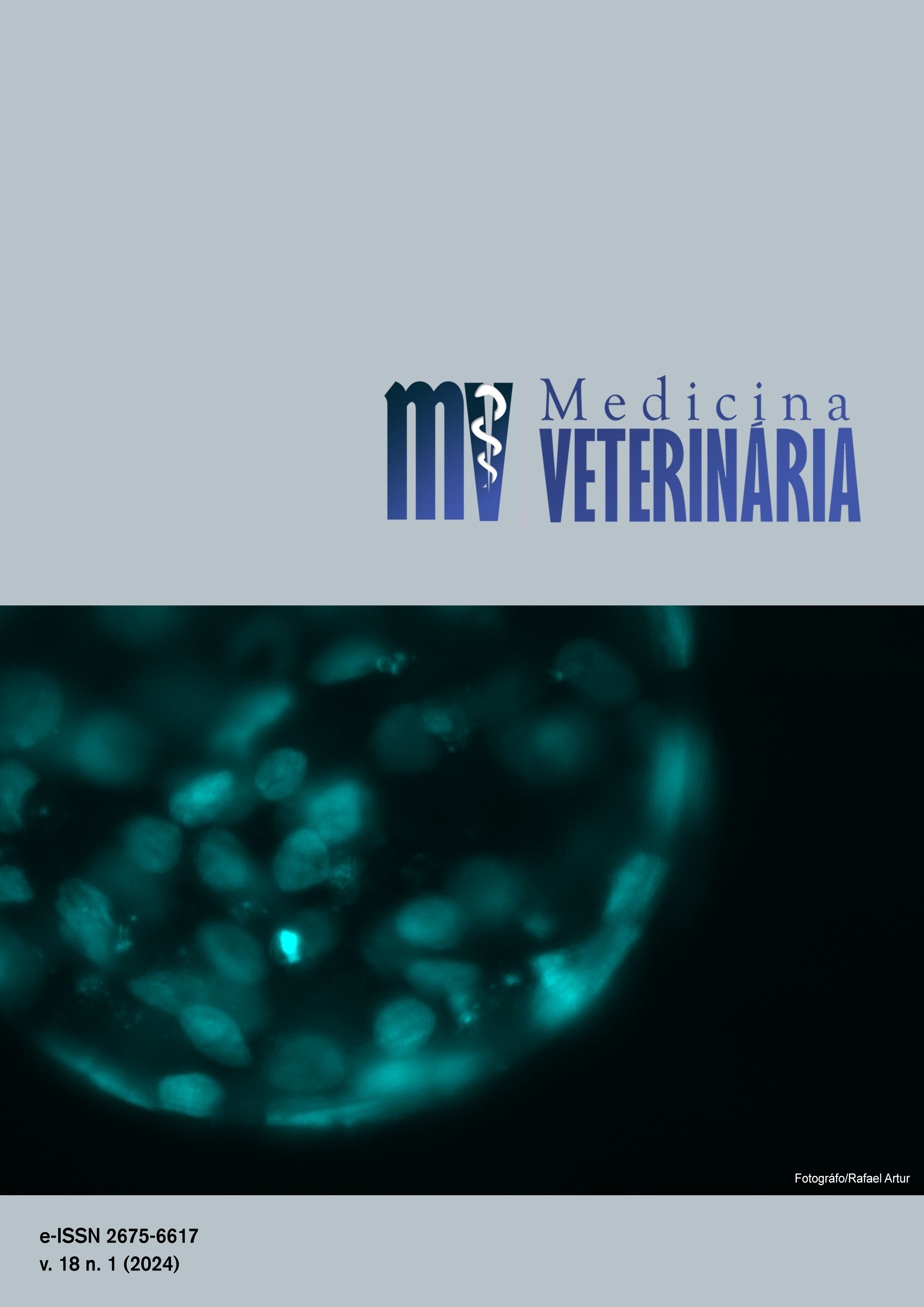Importance of necroscopic examination in the diagnosis of gastric leiomyosarcoma in a dog with sudden death: a case report
DOI:
https://doi.org/10.26605/medvet-v18n1-6526Keywords:
necropsy; mesenchymal neoplasia; immunohistochemistryAbstract
Gastric neoplasms are uncommon in dogs and represent less than 1% of all tumors diagnosed in this species. In a survey of gastrointestinal tumors in dogs, it was found that 90% of malignant neoplasms occur in the stomach and epithelial tumors were more frequent than those of mesenchymal origin. The diagnosis of gastric neoplasms is difficult and often occurs late, making the prognosis unfavorable. In mesenchymal tumors of the gastrointestinal tract, immunohistochemical analysis is essential. This study aimed to report a case of gastric leiomyosarcoma in a dog with sudden death. The animal was referred for necropsy at the UNESP-FCAV Veterinary Pathology Service and two nodules were observed in the cardia, each 2.0 cm in diameter, whitish, rounded, and firm. The stomach presented a bloody food bolus, and the fecal content was blackened throughout the intestinal extension. The cause of death was a hypovolemic shock. On histopathological examination, the mass corresponded to a proliferation of mesenchymal cells with mild atypia, the diagnosis of which was suggestive of gastric leiomyosarcoma. A gastrointestinal stromal tumor (GIST) is the principal differential diagnosis, so histological sections of the gastric nodules were subjected to immunohistochemical (IHC) analysis. The neoplastic cells were positive for S100, 1A4, Desmin, and HHF35 and did not express DOG1, ruling out the origin of GIST tumor cells. The present report demonstrates the importance of necroscopic examination to conclude the cause of death and the immunohistochemical technique to confirm the diagnosis of mesenchymal neoplasms.Downloads
References
Alves, R.C. et al. Clinicopathological and immunohistochemical evaluation of oesophageal leiomyosarcoma in a dog. Ciência Rural, 45(9): 1644-1647, 2015.
Bastianello, S.S. A survey on neoplasia in domestic species over a 40-year period from 1935 to 1974 in the Republic of South Africa. VI. Tumours occurring in dogs. The Onderstepoort Journal of Veterinary Research, 50(3): 199–220, 1983.
Costa, M.L. et al. Diagnósticos histomorfológico e imunofenotípico de tumors estromais gastrointestinais e outros sarcomas que acometem o intestino de cães. Ciência Animal Brasileira, 24: e-75610E, 2023.
Cotchin, E. Some tumors of dogs and cats of comparative veterinary and human interest. Veterinary Records, 71: 1040–1050, 1959.
Crow, S.E. Tumors of the alimentary tract. The Veterinary Clinics of North America. Small Animal Practice, 15(3): 577–596, 1985.
Cullen, J.M.; Breen, M. Pathogenesis, prognosis, and diagnosis. In: Meuten, D.J. Tumors in domestic animals. 5a ed. Ames: John Wiley & Sons, 2017. Cap. 1, p.1-26.
Dailey, D.D. et al. DOG1 is a sensitive and specific immunohistochemical marker for diagnosis of canine gastrointestinal stromal tumors. Journal of Veterinary Diagnostic Investigation, 27(3): 268–277, 2015.
Frgelecová, L. et al. Canine gastrointestinal tract tumours: a restrospective study of 74 cases. Acta Veterinaria Brno, 82(4): 387–392, 2014.
Gomez-Pinilla, P.J. et al. Ano1 is a selective marker of interstitial cells of Cajal in the human and mouse gastrointestinal tract. American Journal of Physiology - Gastrointestinal and Liver Physiology, 296: 1370–1381, 2009.
Liptak, J.; Withrow, S.J. Cancer of gastrointestinal tract. In: Withrow, S.J.; MacEwen, E.G. Small animal clinical oncology. 5a ed. Philadelphia: Saunders, 2013. Cap.22, p.381-431.
Marolf, A.J. et al. Comparison of endoscopy and sonography findings in dogs and cats with histologically confirmed gastric neoplasia. Journal of Small Animal Practice, 56(5): 339-344, 2015.
Munday, J.S.; Löhr, C.V.; Kiupel, M. Tumors of the Alimentary Tract. In: Donald, M. Tumors in Domestic Animals. Raleigh: Wiley Blackwell, 2017. Cap. 13, p.499-549.
Patnaik, A.K.; Hurvitz, A.I.; Johnson, G.F. Canine gastrointestinal neoplasms. Veterinary Pathology, 14(6): 547–555, 1977.
Peleteiro et al. Manual de Necrópsia Veterinária. 1ª ed. Lisboa: Lidel, 2016. 170p.
Rivers, B.J. et al. Canine gastric neoplasia: utility of ultrasonography in diagnosis. Journal of the American Animal Hospital Association, 33(2): 144–155, 1997.
Singh, R.D. et al. Ano1, a Ca2+-activated Cl? channel, coordinates contractility in mouse intestine by Ca2+ transient coordination between interstitial cells of Cajal. The Journal of Physiology, 592: 4051–4068, 2014.
Swann, H.M.; Holt, D.E. Canine gastric adenocarcinoma and leiomyosarcoma: a retrospective study of 21 cases (1986-1999) and literature review. Journal of the American Animal Hospital Association, 38(2): 157–164, 2002.
Terragni, R. et al. Diagnostic imaging and endoscopic finding in dogs and cats with gastric tumors: a review. Schweizer Archiv Für Tierheilkunde, 156(12): 569–576, 2014.
Von Babo, V. et al. Canine non-hematopoietic gastric neoplasia. Epidemiologic and diagnostic characteristics in 38 dogs with post-surgical outcome of five cases. Tierärztliche Praxis Ausgabe K: Kleintiere/Heimtiere, 40(4): 243–249, 2012.
Zuercher, M.; Vilaplana, G.F.; Lejeune, A. Comparison of the clinical, ultrasound, and CT findings in 13 dogs with gastric neoplasia. Veterinary Radiology & Ultrasound, 62(5): 525–532, 2021.
Wang, X.Y. et al. Discrepancies between c-Kit positive and Ano1 positive ICC-SMP in the W/Wv and wild-type mouse colon; relationships with motor patterns and calcium transients. Neurogastroenterology & Motility, 26: 1298–1310, 2014.
Downloads
Published
How to Cite
Issue
Section
License
Copyright (c) 2024 Bethânia Almeida Gouveia, Ana Paula Luiz de Oliveira, Fernanda Ramalho Ramos, Mariana Klein, Karina Perez da Silva , Stella Habib Moreira, Rosemeri de Oliveira Vasconcelos

This work is licensed under a Creative Commons Attribution-NonCommercial-ShareAlike 4.0 International License.
A Revista de Medicina Veterinária permite que o autor retenha os direitos de publicação sem restrições, utilizando para tal a licença Creative Commons CC BY-NC-SA 4.0.
De acordo com os termos seguintes:
Atribuição — Você deve dar o crédito apropriado, prover um link para a licença e indicar se mudanças foram feitas. Você deve fazê-lo em qualquer circunstância razoável, mas de nenhuma maneira que sugira que o licenciante apoia você ou o seu uso.
NãoComercial — Você não pode usar o material para fins comerciais.
CompartilhaIgual — Se você remixar, transformar, ou criar a partir do material, tem de distribuir as suas contribuições sob a mesma licença que o original.
Sem restrições adicionais — Você não pode aplicar termos jurídicos ou medidas de caráter tecnológico que restrinjam legalmente outros de fazerem algo que a licença permita.







